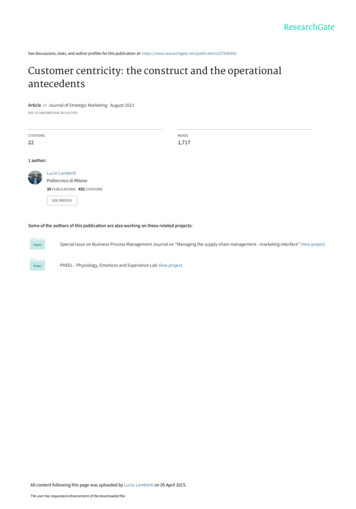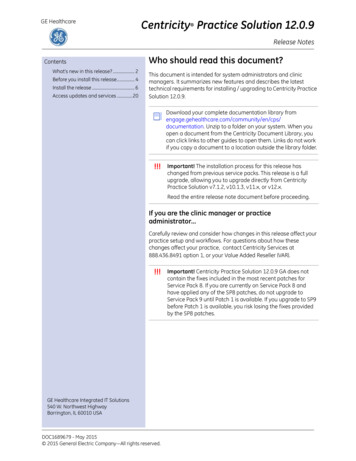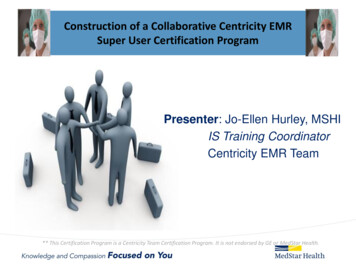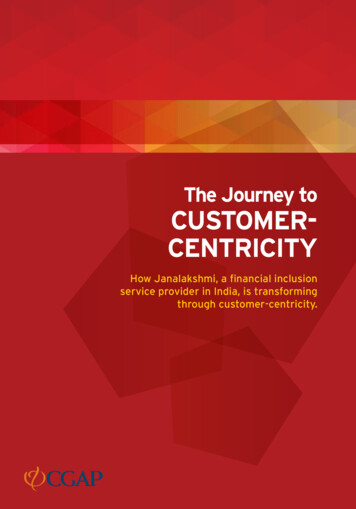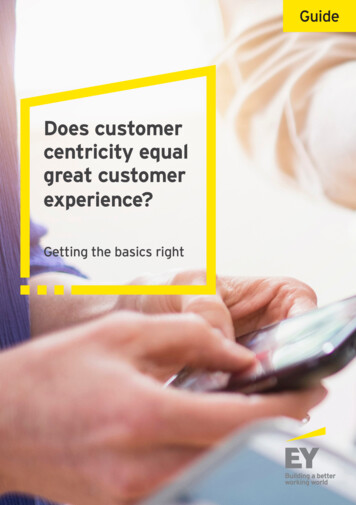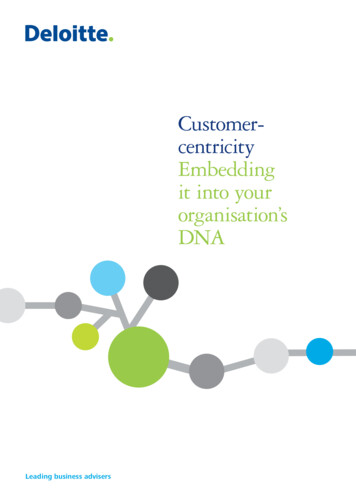
Transcription
International Journal of Business and Social ScienceVol. 5, No. 5(1); April 2014Integrate Customer Centricity into Event Management: A Special Children EventStudyLu MiaoBachelor of International Hospitality and Tourism ManagementUniversity of Queensland9 Moorgate Street, Macgregor, QLD 4109AbstractPurpose- The aim of this paper is to contribute some inspirations to the concept of customer centricity referringto event management, to see how customer-focused structure and climate in general business organization can beapplied to event context and to test if there are subtle differences between, so that event managers can enhancetheir practice.Approach- The author undertakes this objectives by means of conducting a case study, using an event for specialchildren as an example and manipulating deductive reasoning to analyze the case after bibliography review.Findings- The relationship between customers and volunteers is an important part of the success of eventexperience. Since volunteers play roles both as service providers and audiences in majority events, volunteersmanaging can be a critically significant step to achieve customer centricity in event.Keywords: customer centricity; event management; volunteer1. Introduction1.1. Service experienceThe author attended an event called Special Children Christmas Party. This is an annual event designed forspecial children, aiming to give them an unforgettable memory.To protect those special kids, the event was not open to the public and all the activities were free. Enrolled as oneof the volunteers to deliver ice-cream, the author experienced the whole process of the event. When stepping intothe exhibition hall, the author felt so touched to see that the entrance was divided into three parts:one for generalcustomers, which contained ramp for wheelchairs, one for sponsors and one for volunteers, and it seemed veryorganized. Besides, every child was given a wrist belt, which had their parents phone number written on it in casethey got lost.Children and their parents would be asked to write down their Christmas wish list ahead of time. For instance,some children might have dreams to meet their favourite heroes, but unfortunately due to their blind eyes, theyhad never seen Spiderman or superman before. The staff dressed up as different characters so that children couldtake photos and played with them. Moreover, each child could get a gift package particularly designed for them.The author could simply tell the satisfaction and happiness from those kids and their parents smiling face. Mostfamilies maintain a stable relationship with the event holders and would attend every year.1.2. Relevant service management conceptThis paper chooses customer centricity to explain this service experience. In his groundbreaking work on thetypology of customer centricity nearly sixty years ago, Drucker (1954) suggested that “it is the customer whodetermines what a business is, what it produces, and whether it will prosper.” The essence of this concept lies increating value, involving a win-win process both for customers and firms, rather than merely selling products(Boulding, William, Kalra, Staelin, & Zeithaml, 1993). Similarly, the basic philosophy of it is to get “all decisionsstart with customers and opportunities for advantage”(Shah, Rust, Parasuraman, Staelin, &Day, 2006).The reason why the service experience can match and related to customer centricity well can be listed as follows.First of all, the whole event was designed for customers and served for customers. To be more precise, event’spurpose was to help fulfill special children’s Christmas dreams so almost all aspects reflected their goals.107
Center for Promoting Ideas, USAwww.ijbssnet.comThe event holder took into account different questions customers might ask and respond by carrying out theiraction. Through offering ramp and other devices for wheelchairs, managers answered how can disabled childrenaccess to the event; through providing wrist belt, managers answered what if special kids got lost in the venue.Not only did they cater for customers’ special needs, the event also paid attention to customers individual needs:the Christmas wishes list and the specific packaged gifts for every child were powerful evidences. Moreover, thecharacteristics of “private event” and “free event” expanded customers’ experience to their fullest so that childrenwould not be disturbed while they steeped in the atmosphere. Besides, the event gain its value from customers. Byproviding the very best for its customers, event acquired customers satisfaction and loyalty, for the specialchildren’s families would spread good word-of-mouth and invited their close friends to join annually.2. Literature review2.1. Conceptual frameworkAs mentioned above, customer centricity is not a new term. What is new is that it more and more becomes aprevalent trend among various organizations, encompassing the full spectrum of service companies andmanufactures. It gradually changes the nature of business competitive advantage, which shifts from supply chaintargeting on efficiency orientation to a view that encouraging customers to participate into continuous innovation(Cahn, 2000). Sheth, Sisodia and Sharma(2000) summarized five trends to elaborate why this transformationhappened, which are intensifying pressures to improve marketing productivity, increasing market diversity,intensifying competition, demanding and well-informed customers, and accelerating advances in technology. Dueto its wide-spread merits, firms start to realize the urgency to prioritize their customer base (Mahadevan &Kettinger, 2011).In fact, however, the customer centric paradigm only exists in a small group of companies (Shah et al. 2006).Even if customer centricity was established, it is still hard to completely align and sustain and what these firmsactually do is running a product-centric firms in disguise (Galbraith 2005). Hence, customer centricity becomes abuzzword in contemporary society but also a malaise that causes business communities to struggle.Many scholars once gave thought to tackle this problem, one of those noteworthy theories is Shah et al. (2006)’sPath to Customer Centricity Model. In their fruitful work, Shah et al. suggest a road map driven by leadershipcommitment, system and process support, revised financial metrics and organizational realignment to break thebarriers on the way to achieving customer centricity. According to them, organization culture, structure, processand financial metrics can boost or impede the change from product centricity to customer centricity, whatcorporations need to do is to use the four tools mentioned above to accelerate the development. As illustrate inFigure 1, the service culture influences the way of information sharing, marketing investment and the time scalespend with customers, so altering behavior patterns can help to change culture. One of the most effective methodsis to encourage managers to spend time with customers and to tell their service stories among the company, whichcan ensure the superior quality of customer relations. As for the structure, product-focused companies have manyoverlapping functions which cannot be flexible to respond to small or personal customer unit. Therefore, it isnecessary to use horizontal organization to replace vertical hierarchy to accomplish fuller structural alignment sothat information can flow more fluent between departments. All four tools are interrelated, culture and structurechange also require the systems and process support from different perspectives, and need to audit the intangibleissues(customer equity, customer satisfactory, customer lifetime value etc.) by tracking financial metrics.Shah et al.’s model can be adapted and applied to fulfill customer centricity in event, giving great inspirations toevent marketers. However it should notice some differences between customer centricity in general businessindustries and event, which will be discussed afterwards.108
International Journal of Business and Social ScienceVol. 5, No. 5(1); April 2014Figure 1.Shah et al. (2006)’s Path to Customer Centricity Model2.2. Customer centricity in eventNowadays, event industry springs like mushrooms. Unlike general organizations, event can be used as a partialtool for companies to achieve customer centricity, or the event itself can also be designed as an organization tobring out customer-focused activities, here general organizations refer to service companies and manufactures.However, despite the increasing academic contributions that examine customer centricity and event management,rarely of them link those two concept together. Even if some of researchers ponder how to promote customers’value in event, they seem to ignore the subtle differences between customer centricity in general organization andevent. In the author’s opinion, one of the nuances lies in who contact customers and deliver this service approach.Customers evaluate service from functional (the technical quality of offering), mechanistic(sensory presentationof service), and humanistic(behavior and appearance of service provider) (Solnet, 2006). So the service providerwill direct or indirect impact on customer satisfaction (Heskett, Sasser, & Schlesinger, 1997). In generalorganizations service encounter happens between employees and customers while in event to a large extent it isthe volunteer who represent the event to serve customers. This article then compares the distinguishing featuresbetween customer centricity in general organizations and event, which are showed in Table 1.109
Center for Promoting Ideas, USAwww.ijbssnet.comA comparison of customer centricity in general organizations and pt a horizontal structure or aHybrid one that combine horizontalAnd vertical structureeventMore complex and loose structure,Involving different groups, like eventholder, sponsors, media, co-workers(volunteers), participants and spectatorsPerformance metricsShare of wallet of customers,customer Satisfaction, customerlifetime value, customer equityBesides, also include the perceivedquality of shareholders, spread pf WOMand Multiplier effectManagement criteriaPortfolio of customersPortfolio of visitors(including but notrestricted to customers)Who contactcustomersDirectly(in mostcases)challengePaid employeesvolunteersAlign information sharing betweendifferent units; manage employees’deviant behaviorsHard to manage and train volunteers, HRissues like system of reward,punishment, recruitment are hard toestablished and supervised; groupidentity and job boundaries are not thatclear; properly adapt non-financialmotivation; hard to chase feedbacks ofvisitorsTable 1.Volunteers are those people who provide unpaid help in organized manner to parties to whom they have noobligations (Musick & Wilson, 1997). Without monetary compensation and material incentives for theirlivelihood, volunteers can only depend on intangible reward, which is differ most significantly from paidemployees ( Shin & Kleiner, 2003). Therefore, well-organized volunteer management is crucial to the success ofcustomer centricity in event.Different celebrities give out different viewpoints on this issue. One measure is to categorize volunteersmotivation so that managers can know how to manage their behaviors. Among all those motivations ranging fromtime and cost sacrifices to social value, learning and job satisfaction are thought to be the most important ones(Kemp, 2002). Emphasizing more on what volunteers can derive from the event serving do help to thiscommunication. In addition, work environment can gradually influence their initial intentions, so creating aservice environment is necessary to keep them being motivated.The second method is that managers can enhance organization practice by capitalizing on employee identity(Solnet, 2006). His surprising finding is that “the degree to which hotel employees perceived themselves asmembers of their company made the only contribution to the prediction of customer satisfaction”.Since volunteers are “hidden workforce”(Kemp,2002), human resource issues can also suit to volunteermanagement. To do this, managers need to be more careful to carry out recruiting, planning, training, supervisionactivities, companied by proper recognition of their work ( Shin & Kleiner, 2003).No matter adopting which method to manage volunteers in event, one thing for certain is that from a socialpsychological perspective, hedonistic and altruistic can foster volunteers’ service, even inducing better effect thanpaid workers, which can pour on the satisfaction of customers.110
International Journal of Business and Social ScienceVol. 5, No. 5(1); April 20143. Recommendations: managerial implicationsBased on the past work review, event managers can draw numbers of important implications. After combiningShah et al.’s Path to Customer Centricity Model and other scholars’ theories on how to manage volunteers, theauthor get a model of how to integrate customer centricity into event (Figure 2).Looking back to the author’s service experience, there are some aspects the special children event still have roomto promote. For example, beforehand event managers can give registered volunteers’ a job description listed whatskills and advantages they would get by participating in the event so that they could be maximum motivated.Secondly, improve the overall quality of event and make it become more famous and make it become moreprofessional, which will increase volunteers’ group identity and be more proud and willing to serve. Thirdly, postrecognition including dinner, thank you cards, gifts or reference letters and post-tracking of volunteers feedbackwould be more appreciated.There are also numerous of advantages of this event. Firstly, this event carried out a relatively horizonal structurewhich made volunteers feel being treated with respect and is helpful for information flowing. Secondly, eventleaders were also commit to the service and spend time with special children’s families via photo taking, stageperforming, and stories sharing. Thirdly, managers encourage volunteers to participate into the event byempowering them to change rotations and shifts so that they will not get bored, also by allowing volunteers to jointhe set up process of the event, like decorating Christmas trees. Through this process, volunteers got a goodtraining about the event information (i.e. Layout) and freedom to decide their working environment. Fourthly,event provides T-shirt for volunteers to enhance their group identity.Figure 2.Author’s conception of integrating customer centricity in eventSource: Adapted from Shah et al.’s Path to Customer Centricity Model111
Center for Promoting Ideas, USAwww.ijbssnet.com4. Conclusion, Limitations and Future ResearchTo restate the purpose, this essay tries to combine relevant theories of customer centricity and the event casestudy, to analyze how the author’s experience demonstrates this point well and to throw light on future practice.To outline the structure, this paper begins with an overview of earlier doctoral dissertations, which are thefoundation of theoretical background. These assist to determine the path to customer centricity in event, followedby detailed discussion on the experience example of the framework in use and the implications of each.The author considers that only apply what general organizations do to guide event managers achieve customercentricity is far from enough, because of several differences between them. One of which is that it is thevolunteers rather than paid employees who serve the customers and influence their feelings about the process inevent. Therefore, except other factors, volunteer managing is vital in achieving customer centricity in event.Understanding this can help to develop various methods to integrate customer orientation into event morecorrectly.The author also acknowledges that there are several limitations of this study, which can also be some suggestionsfor future research. Due to paucity of survey to investigate feedback of customers about the case event, this paperuses volunteers’ observation and perception of customer satisfaction rather than responses taken directly fromcustomers, which probably causes some invalidity of the result. This might be compensated by a qualitativeresearch. Also the drafted framework also needs a longitudinal research to complement the findings and offset theshortcomings of self-report.There is still potential that managers can tap into customer centricity, especially in event context. Then, how farshould we go? Perhaps to paraphrase Fitzpatrick (2006)’ saying can best answer this question: The moreexpansive the service bundle you can propose and the more you glued together all the elements of your bundle,the more customer centric you can or should be.ReferencesBoulding, Willaiam., Ajay,Kalra., Richard Staelin., & Valarie, A. Zeithaml. (1993). A Dynamic Process Model ofService Quality: From Expectations to Behavioral Intentions. Journal of Marketing Research, 30(1), 7.Cahn, David, M,.(2000). Customer centricity and value creation. Manufacturing Systems, 18(5), 28.Drucker, Peter.(1954). The Practice of Management. New York: HarperCollins.Fitzpatrick, Robert. (2006). Designing the Customer-Centric Organization: A Guide to Strategy, Structure andProcess. Personnel Psychology, 59(1), 252.Galbraith, Jay, R. (2005). Designing the customer-centric organization: a guide to strategy, sytucture, andprocess. San Francisco: Jossey-Bass.Heskett, J. L., Sasser, W. E. & Schlesinger, L. A.(1997), The Service-Profit Chain, Free Press, New York, NY.Kemp, Sharon. (2002).The hidden workforce: Volunteers’ learning in the Olympics. Journal of EuropeanIndustrial Training, 26,109.Solnet, David. (2006). Introducing employees social identification to customer satisfaction research: A hotelindustry study. Managing Service Quality, 16,6,575-594.Shin, Sunney., & Kleiner, Brian H.(2003). How to manage unpaid volunteers in organisations. ManagementResearch News, 26, 2-4Shah, Denish., Rust, Roland,T., Parasuraman, A., Staelin, Richard.,& Day, George, S.(2006).The Path to Customer Centricity. Journal of Service Research, 9, 113.112
1.2. Relevant service management concept This paper chooses customer centricity to explain this service experience. In his groundbreaking work on the typology of customer centricity nearly sixty years ago, Drucker (1954) suggested that "it is the customer who determines what a business is, what it produces, and whether it will prosper."

